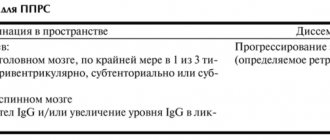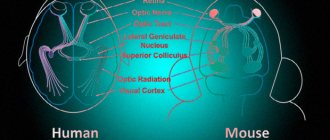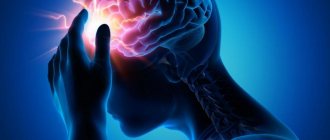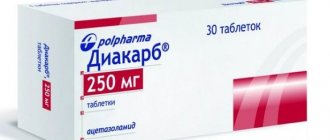Features of the pathology
The disease most often affects women aged 30-45 years living in Southeast Asia, for example, Japan; in men, neuromyelitis optica is extremely rare.
Important! The process of damage to the nerves and tissues of the spinal cord can be stopped, but an advanced stage often leads to irreversible consequences.
Classification
Symptoms of the disease may occur simultaneously or sequentially. In most clinical cases (up to 80%), the onset of the disease begins with a unilateral or bilateral inflammatory process in the optic nerves (neuritis). Myelitis develops weeks, months and even years after visual impairment. Much less often, autoimmune inflammation simultaneously occurs in both the optic nerve and the structures of the spinal cord.
Depending on the nature of the course of neuromyelitis optica, several forms of the pathological process are distinguished.
- Monophasic course - occurs in 20% of cases, develops more often in children and young patients, is characterized by the simultaneous occurrence of myelitis and optic neuritis, and does not cause relapse of the disease.
- Recurrent course - occurs in 80% of cases, develops in mature patients, and is characterized by the sequential occurrence of optic neuritis and myelitis.
In the monophasic form of the disease, more severe disorders of the central nervous system occur than in the recurrent course. At the same time, frequent exacerbations of the disease lead to worsening neurological symptoms, which makes the prognosis for the recurrent form less favorable for recovery, preservation of vision and motor function.
Symptoms of neuromyelitis optica
Disturbances in the functioning of the optic nerve are characterized by the following symptoms:
- Patients complain of a veil in the eyes, visual perception becomes fuzzy and blurry.
- During the test, pallor, swelling, and atrophy of the optic discs may be observed. What is characteristic is that the fundus of the eye remains unchanged.
- Pain in the affected area.
Malfunctions of the spinal cord are associated with damage to the nervous tissue, which can be partial or complete. In this case, the following signs of the disease are observed:
- Muscle weakness, loss of sensation, paralysis of 2 or 4 limbs at once.
- Encopresis, urinary retention.
- Hyperhidrosis, respiratory system disorders, tachycardia.
Treatment
Treatment of Devic's neuromyelitis optica is a difficult process. The main goal of doctors is to slow down the progression of pathology and improve the patient’s quality of life. For pathogenetic therapy, drugs that inhibit B-cell function (mitoxantrone) were previously popular. At the moment, monoclonal antibodies that suppress autoimmune inflammation are considered more effective. An example is rituximab.
To stop the exacerbation of the disease, glucocorticosteroids are used in large doses - prednisolone, hydrocortisone, dexamethasone. Partial blood purification from circulating immune complexes is carried out using plasmapheresis.
https://www.youtube.com/watch?v=https:accounts.google.comServiceLogin
Symptomatic therapy is used to improve the patient's quality of life.
Groups of drugs used:
- Muscle relaxants. Medicines reduce pathological hypertonicity. Representatives: dantrolene, tolperisone.
- Antidepressants. Improves the emotional state of patients. Representatives: imipramine, amitriptyline.
- Centrally acting painkillers – pregabalin.
Therapeutic exercise and physiotherapy are auxiliary techniques that help increase the effectiveness of basic therapy. The practice uses electrophoresis, massage, and paraffin baths.
Diagnostics
In order to distinguish the pathology in question from others, Miller's criteria are used.
Miller's Grand Criteria:
- Optic neuritis, which can develop on one side or both at once.
- Magnetic resonance imaging, which reveals damage to several segments of the spinal cord.
- Absence of other autoimmune diseases.
Small Miller criteria:
- Neuromyelitis optica is characterized by an increase in the level of leukocytes found in the cerebrospinal fluid.
- Presence of aquaporin-4 marker in the analysis.
- With neuromyelitis optica there are no such brain lesions as with other pathologies associated with autoimmune disorders.
Three major and any of the minor signs give reason to speak about the presence of neuromyelitis optica.
Therapy
Treatment of this disease requires an integrated approach. It is complicated by the contradictory results of the use of immunosuppressive and immunomodulatory drugs. Of the 6 drugs registered in the world for the treatment of neuromyelitis optica, 3 are interferons with unproven clinical effectiveness. Plasmapheresis and high doses of corticosteroids can stop attacks. If there is no effect, mitoxantrone and rituximab may be prescribed. Prednisolone can prevent exacerbation.
Symptomatic therapy includes:
- Antidepressants;
- Muscle relaxants;
- Intrathecal baclofen infusion;
- Physiotherapeutic procedures: SMT, electrophoresis, paraffin therapy;
- Massage;
- Exercise therapy.
Difference between neuromyelitis optica and multiple sclerosis
For a long time, neuromyelitis optica was considered one of the stages of multiple sclerosis. However, after a marker specific for this disease, aquaporin-4, was identified, neuromyelitis optica was moved to a separate group. Opticomyelitis is characterized by a more severe course and obvious signs than multiple sclerosis.
Features of Devic's syndrome:
- Difficulty performing simple movements of the limbs.
- Impaired functionality of the organ of vision, which can lead to blindness of the patient.
- The disease is very difficult.
- Damage to several segments of the spinal cord, subsequently leading to paralysis.
- The lesion does not affect the brain.
- Bilateral transverse lesions of spinal cord segments.
- The number of leukocytes exceeds 50 cells.
- Presence of a marker - aquaporin-4
Features of multiple sclerosis:
- Slow development of pathological processes.
- Due to damage to the optic nerves and brain, paralysis and blindness occur extremely rarely.
- The spinal cord is affected only in 1 segment.
- No pleocytosis was detected in the cerebrospinal fluid.
- There is no marker - aquaporin-4.
Causes
ONM belongs to the group of idiopathic diseases, the nature of which is not fully understood. The mechanism of development of the pathological process is autoimmune in nature. Due to unknown causes, the body produces antibodies to the myelin sheath of nerve fibers, which are located in the optic nerve and spinal cord. Recent scientific studies have proven that autoantibodies of the Ig G class are synthesized against a protein substance - aquaporin-4. It is located in the membrane of nerve cells, is part of the tubules that regulate water metabolism, and is called NMO-IgG.
Aquaporin-4 is found in large quantities in the structures of the optic nerves, spinal cord and brain - the hypothalamus, medulla oblongata, and periventricular areas. However, specific autoimmune inflammation with clinical manifestations occurs exclusively in the spinal cord and optic nerves. In the brain, areas of inflammation occur rarely or do not cause neurological symptoms. Autoantibodies damage small arterial vessels and capillaries, which leads to disruption of the blood supply to the nervous tissue and its necrosis.
Devic's disease leads to disability
Neuromyelitis optica often occurs against the background of other autoimmune diseases or precedes them. In some cases, the combined occurrence of pathology with Sjögren's disease, vasculitis, and systemic lupus erythematosus is recorded. Similar morphological changes develop with infectious and non-infectious lesions of the spinal cord and organ of vision, which requires differential diagnosis between diseases.
Diagnostic measures
In case of neuromyelitis optica, the patient is recommended to consult a doctor. The specialist examines the patient and collects anamnesis, which allows him to make a preliminary diagnosis. To confirm this, additional measures are recommended. An important aspect of Devic's disease is its differentiation from such pathological processes as:
- Recurrent myelitis;
- Disseminated encephalomyelitis;
- Recurrent renobulbar neuritis;
- Myelopathy.
For this purpose, it is recommended to conduct a study of cerebrospinal fluid, for the collection of which a lumbar puncture is used. If the disease has an acute stage of development, then using the analysis of cerebrospinal fluid, the determination of preocytosis and typical oligoclonal antibodies for multiple sclerosis is ensured.
During the course of the pathology, a blood test for antibodies . During the course of the pathological process, antinuclear and antirheoid antibodies are detected in the biofluid. If a pathological process is suspected, the patient is recommended to undergo an examination by an ophthalmologist.
Using a special ophthalmoscope apparatus, a specialist checks visual acuity and examines the fundus of the eye. Thanks to this diagnostic procedure, it is possible to determine pallor, blurring and swelling of the optic nerve head, even in the absence of corresponding symptoms. To accurately determine visual impairments, it is recommended to conduct an examination of visual EP.
A highly informative technique for diagnosing a pathological process is magnetic resonance imaging. With its help, it is possible to display layer-by-layer images of the spinal cord and identify lesions that are necrotic in nature .
If a disease is suspected, magnetic resonance imaging of the brain is recommended, which makes it possible to visualize pathological foci in the hypothalamus. During the examination, other cerebral structures are observed to be intact.
Magnetic resonance imaging is used to differentiate the disease from multiple sclerosis.
Diagnosis of neuromyelitis optica should be comprehensive, which will make it possible to determine the degree of damage to the body and prescribe effective therapy.











